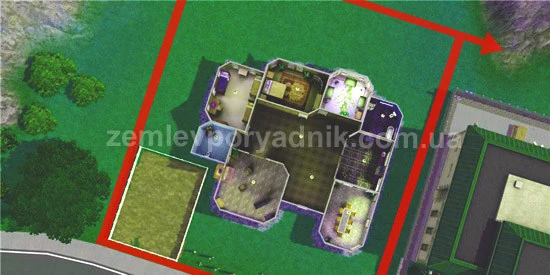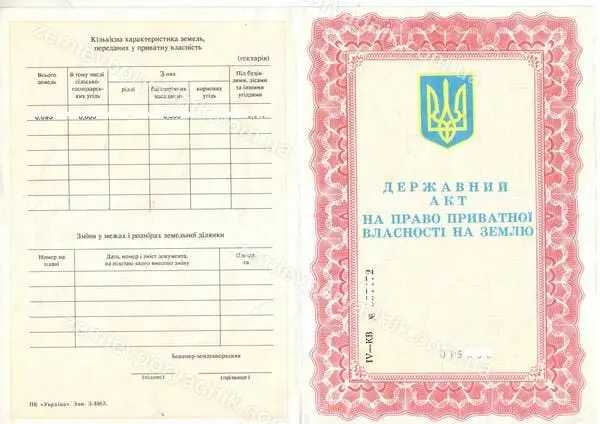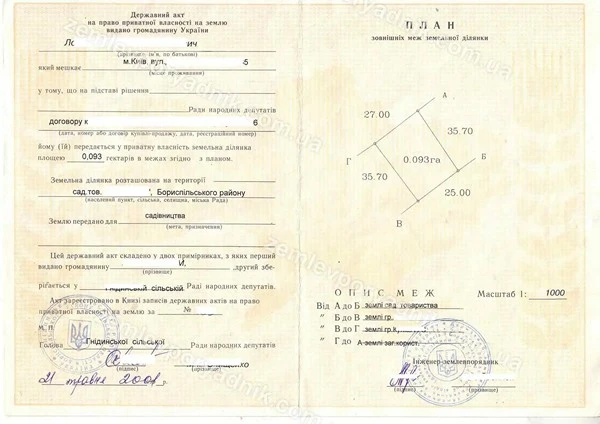The procedure for assigning a cadastral number to a land plot in Ukraine in 2024
What is a cadastral number and why is it needed
The cadastral number of a land plot is a unique 19-digit number by which a land plot is registered in the State Land Cadastre. This number consists of four blocks of digits separated by colons in the format 0000000000:00:000:0000, which are decoded as follows:
- the first block of ten digits indicates the number of the administrative unit (region, district, part of the district, territory of a village or city council). For example, 3220881700 will mean the territory of Voronkivska village council of Boryspil district of Kyiv region;
- the second block of two digits indicates the cadastral zone on the territory of the administrative unit;
- the third block of three digits means a cadastral quarter on the territory of the cadastral zone;
- the fourth block of four digits means the number of the land plot in the cadastral quarter.
As you can see, the structure is quite logical and simple. An example of a cadastral number is 3222481201:01:001:0001. This means that land plot number 1 is located in cadastral quarter 1, cadastral zone 1, on the territory of the Vito-Poshtova village council.

Why do I need a cadastral number of a land plot? As mentioned above, a cadastral number is the main identifier of a land plot in the State Land Cadastre.
Without a cadastral number, it is currently impossible, in particular, to acquire ownership or use of a land plot, inherit a land plot, calculate the normative monetary and expert valuation of a land plot, impose an easement, etc.
There are also boundary risks. Let's say you use a fenced area around a residential building without an assigned cadastral number. Your neighbors have assigned a cadastral number, and later it turns out that part of your land plot is under their cadastral number. And you, accordingly, cannot assign a cadastral number to your plot within the area fenced off and permitted by applicable law. This can turn into a legal dispute for many years with unpredictable results.
Such risks can be virtually eliminated if you take all the steps to assign a cadastral number to your own land plot in a timely manner. As a rule, the StateGeoCadastre system does not provide technical capabilities to register a neighboring land plot with an overlay on your already registered land plot.
When a cadastral number is assigned
Here are the cases when a cadastral number is assigned to a land plot. Among them, in particular:
- allocation of a new land plot under a land management project. For example, the allocation of a plot to a citizen within the area of free privatization based on a decision of the local territorial community (currently, this possibility is blocked during martial law in Ukraine). Or allocation of a land plot for lease under a non-residential building owned by a person. The important thing here is that it is possible to allocate (form) under the land management project only the land plot that does not yet have a cadastral number;
- privatization of a land plot under a residential building, the ownership of which is registered with a person. This implies that the person actually uses such a plot, but does not have the relevant documents for it. In such a case, the cadastral number is assigned based on the technical documentation for establishing the boundaries of the land plot in kind (on the ground);
- assignment of a cadastral number to a land plot for which an old-style state act issued before 2004 did not contain a cadastral number. According to the law, such a plot is considered to be formed within the area specified in the state act. In order to assign a cadastral number to such a plot, it is necessary, as in the previous case, to develop technical documentation for establishing the boundaries of the land plot in kind (on the ground);
- assignment of a cadastral number based on the results of the land inventory, on the basis of technical documentation on land inventory prepared by the land surveyor;
- a new cadastral number is also assigned in case of formation of land plots as a result of division (amalgamation). In this case, the old cadastral number is transferred by the cadastral registrar to the archive layer of the State Land Cadastre;
- assignment of a cadastral number to the land plot of the holder of the certificate of the right to a land share. Importantly, such a certificate can be used only until January 1, 2025.
The procedure for assigning a cadastral number to a land plot
Above we have listed the main cases of assigning a cadastral number to a land plot. Next, we will consider the procedure for assigning a cadastral number for specific cases:
- privatization of a land plot under a residential building (suitable when there is only one owner of the building or when there are two or more co-owners); or
- when the owner of the land plot holds an old-style state land ownership certificate issued before 2004 without a cadastral number.

In these cases, the cadastral number is assigned on the basis of technical documentation for establishing the boundaries of the land plot in kind (on the ground), which does not require permission for its development from local authorities.


If your case involves assigning a cadastral number to a land plot on the basis of a decision to grant permission to develop a land management project for the allocation of land for ownership or use, we recommend reading our article on land management project for land allocation.
Thus, the full procedure for assigning a cadastral number is as follows.
Step 1. Select a land surveyor who will perform the work of assigning a cadastral number.
It is necessary to choose a land management organization that employs a certified land surveyor and enter into an agreement with them to perform the relevant work. As a rule, this is a contract for land surveying work, which specifies the subject matter, price, result, list of source documents, timeframe for completion of work and other conditions.
2 step. Performing a cadastral survey of the land plot.
A cadastral survey is essentially a visit by a surveyor and/or land surveyor to the site and measurements of the perimeter of the site, fencing, contours of buildings and other objects on the site.
The measurements are made with professional equipment (total station, GPS RTK or special drone), which must be verified (an exception may be made if it is new). The collected information in digital format is transferred to the land surveyor's office for the third step.
In terms of time, cadastral surveying usually takes an hour or more on-site. However, surveyors or land managers usually plan a visit in a few days. Depending on the workload.
Step 3. Development of technical documentation to establish the boundaries of the land plot in kind (on the ground)
In our case, the technical documentation is an A4 booklet containing graphic and textual materials about the land plot. It includes, in particular, the following documents:
- application of the customer for the development of technical documentation;
- terms of reference for the development of documentation;
- duly certified copies of title documents to the land plot (state act, contract, certificate, etc.);
- duly certified copies of the title documents for the real estate object on the land plot (contract, certificate, etc.);
- a duly certified copy of the technical passport for the building;
- cadastral plan of the land plot;
- materials of urban planning documentation;
- information on restrictions imposed on the land plot;
- a copy of the customer's passport, identification number;
- geodetic survey materials.
The developed technical documentation is signed by the customer, a certified land surveyor and the head of the land surveying organization. After that, we move on to the next step.
In terms of time, this step can take from 2 days to 2-3 weeks, depending on the workload of the land surveyor, as well as your agreements with him. We all know that it is possible to do it quickly, but the price of this option is usually higher.
Step 4. Registration of a land plot in the cadastre and assignment of a cadastral number
The completed technical documentation is submitted by a certified land surveyor for registration with the State Land Cadastre. Previously, this had to be done physically. That is, you had to bring the developed documentation to the cadastre authorities or to a service center. Now the documentation is submitted electronically, but only from the land surveyor.
The submitted documentation is distributed to a state cadastral registrar selected at random. This is called the principle of extraterritoriality. It is a very effective mechanism in eliminating corruption risks. Imagine that a land surveyor developed the documentation in Kyiv, and the registrar reviews it somewhere in the Ternopil region. Or Kharkiv, or Vinnytsia. Each time the documentation is reviewed by a different registrar.
Based on the results of the review, the registrar assigns a cadastral number to the land plot. The registrar prepares an extract from the State Land Cadastre. This extract is the result of the land surveyor's work.
Such registration usually takes 7-14 days. According to the procedure for maintaining the State Land Cadastre, it takes up to 14 working days. Sometimes a positive result can come in 1 day if the registrar is in a good mood).
In general, the procedure for assigning a cadastral number to a land plot takes approximately 1-1.5 months. These are the previous four steps.
Step 5. Approval of technical documentation for the land plot by the council of the local territorial community
This step is relevant only if the land plot under the residential building is to be privatized. When the owner has a title document for the residential building, but no documents for the land plot. Accordingly, if you have an old-style state certificate without a cadastral number, you skip this step and go straight to step 6.
So, after developing the technical documentation and registering the land plot in the State Land Cadastre, you need to contact the executive committee of the local community council at the location of the land plot. They need to submit the following package of documents:
- a cover letter with a request to review and approve the technical documentation and transfer the land plot to the owner;
- a duly certified copy of the developed technical documentation for establishing the boundaries of the land plot in kind (on the ground);
- an extract from the State Land Cadastre on the land plot, which contains the cadastral number.
Next, the council's executive committee prepares a relevant draft decision to approve the technical documentation and transfer the land plot to the customer. The issue of approval and transfer of ownership is put on the agenda of the next council session.
After the relevant decision is made at the council session, you can receive a paper decision on the approval of technical documentation and the transfer of the land plot to the landlord.
The practice of review time varies greatly and depends on the council. In Kyiv, for example, it can take months or even years. Somewhere in the Gatne territorial community, it can take less than a month.
Step 6. Registration of the right to a land plot in the State Register of Real Property Rights
This step is not necessarily performed by a land surveyor. The customer can independently submit the received cadastral extract, state act or decision of the local council to the local administrative service center to register the ownership of the land plot. For more information on registering the right, see our article on the procedure for registering the right to a land plot.
Registration of the right takes 3-5 business days.
As a result of registration, you receive an extract from the State Register of Real Rights to Land. This extract is the final document in the procedure and confirms the registration of ownership of the land plot.
Assigning a cadastral number to a summer cottage or garden plot
The procedure for assigning a cadastral number to a summer cottage or garden plot differs significantly from the procedure we have discussed in this article. First of all, the difference lies in the need to obtain a permit for the development of a land management project. For more details, please read our article on the procedure for obtaining a permit to develop a land management project for a garden plot, which is also applicable to the case of a summer cottage.
Regulatory and legal acts
- The Land Code of Ukraine;
- The Law of Ukraine "On Land Management";
- The Law of Ukraine "On the State Land Cadastre";
- The Procedure for Maintaining the State Land Cadastre, approved by Resolution No. 1051 of the Cabinet of Ministers of Ukraine dated October 17, 2012. The Cabinet of Ministers of Ukraine;
Also, don't forget to like our beautiful Facebook and Instagram pages;)
Try our new web service for checking land plot data in the State Land Cadastre
What can CadastreService:
- find information about the land plot by cadastral number (form of ownership, category, designated purpose code, type of use, area, as well as address and regulatory monetary value of the land plot, if any);
- check the correctness or availability of the land plot's designated purpose code;
- verify the correctness of the designated purpose of the land plot indicated in the cadastre;
- check the accuracy of the data on the area of the land plot;
- check the correctness of the data on the form of ownership of the land plot;
- check the accuracy of the data on the category of the land plot;
- show the location of the land plot on the map;
- show the overlap of land plots on the map, if any;
- create a route to the land plot using Google Maps.
See also: technical documentation for establishing boundaries, extract from the state land cadastre, land allocation project



